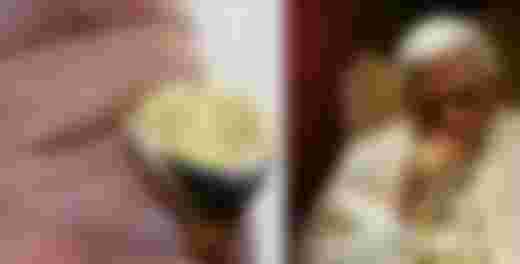On the burial of a pope.
.The Pope must be buried when?
The Pope must be buried within the 4th-6th day after his death. For example, Pope Benedict XVI died on 31st December 2022, and his burial is January 5th, six days after his death.
Usually, in the first three to five days, the body of the Pope is kept inside the Clementine chapel inside the St. Peter’s Basilica for people to view.
On the 4th-6th days, the Papal funeral takes place at the main altar or outside the St Peter’s square. Before the mass, the Pope's body is placed inside three consecutive coffins: CYPRESS COFFIN, LEAD (ZINC) COFFIN and ELM COFFIN.
•Why are the Popes buried in three coffins?

Part of the ritual of burying a Pope includes the ritual of three coffins:
1. The first is a CYPRESS WOOD coffin which symbolises HUMILITY and that the Pope was an ordinary human being.
Included in the coffin will be a copy of the funeral mass and bags of gold, silver and copper coins. The number of coins in each bag match the number of years he was Pope; it's very significant. It's not for him to carry it to heaven, nor because he controlled or loves money , nor to bribe heaven's gate keeper 😂😂.
2. Lead Coffin: The first cypress coffin is then put into a lead coffin. Included in this coffin is a copy of documents he issued under his papal seal. The lead coffin will be soldered shut and have his name, dates of the papacy and a skull and crossbones engraved on top.
Note well: The skull and crossbones are a reminder to us that we are all mortal, that “now is the time for action, for tomorrow we may die”, and as such our eternal destiny must always be set firmly before our eyes. It is also a reminder of the fact that we need to pray for our dead ; an act of mercy and charity that is all too forgotten.
3. The third and final coffin is an Elm coffin(oak): The Lead Coffin is placed in an ELM COFFIN. Elm is rare in Rome and is meant to represent DIGNITY. This coffin includes a parchment in a copper tube with a list of the Pontiff’s achievements. This coffin is then sealed with golden nails.
When each coffin is sealed, it is wrapped with two violet silk ropes. Then it is sealed with wax and coat of arms of the chamberlain and the Cardinal Dean.
•Why are popes buried with red chasubles?

The Chasuble which is red, a liturgical color symbolizes a willingness to shed one's blood for the faith, is the color vestments popes traditionally are buried in.
•Where are the Popes buried?
Popes are buried under the Basilica. There are about 91 popes buried in St. Peter’s Basilica, including the beloved John Paul II who was buried there in 2005. As you walk around the church, you will see some of the most monumental ones in the various niches along the corridors. As time passed, it has been impossible to house all of the popes above ground, so they began housing them below ground in what is called the Papal tombs or crypt.
Benedict XVI will be buried in the Vatican Grottoes, underneath St. Peter’s Basilica, the traditional resting place of popes, in the place where his predecessor was buried before being moved for beautification.
•Why buried with Red Shoes?

While each pontiff has had his own style, red shoes are a papal tradition that goes back centuries; red shoes are as ancient as the Church. Many Popes were even buried with red shoes: Paul VI, John Paul I, and John Paul II, etc.
Pope Benedict XVI stepped away from his red shoes the moment he resigned from the papacy and won't be buried with the red shoes.
Far from a fashion statement, in the Catholic faith, red symbolizes martyrdom and the Passion of Christ. Red symbolized both the worldly authority of the pope and the Passion of Christ. It also symbolized the Pope’s submission to Christ, the love of God for humanity, and the remembrance of all the martyrs who gave their lives for Christ.
•What happens to the Pope's Ring (Fisher man's ring) at death?
According to Vatican tradition, the pope's ring is a sign of Authority and each pope has a ring made in the specification for him. This ring plays a critical role in the running of the Church as signet rings used by popes to put their official wax seals on documents. So that's why the ring has to be destroyed immediately after a pope's death by the Carmelengo infront of the Cardinals; so that no one can use his ring to establish the authority of the Vatican after his death.
However, when Benedict XVI stepped down as pope, his ring was marked with a cross so it can be kept intact, rather than being destroyed.

However on March 6 2013, Jesuit Father Federico Lombardi, Vatican spokesman, told reporters that this "destruction" had been completed, although he explained that the ring is not smashed or destroyed completely; rather, two deep cuts are made in its face so that it can no longer be used as a seal." This is so because such marks would invalidate the seal on the ring. But why not destroy it completely like others? Is it because he only resigned? Would it be destroyed completely now that Benedict XVI is dead?
•Who assumes authority when a Pope dies?
The Camerlengo or Chamberlain (THE VATICAN SECRETARY OF STATE) assumes the Papal authority till a new Pope is elected. He also organizes the election of the new Pope. He summons all the cardinals of the world to Rome for a new Pope to be elected.
In the case of the late Pope Benedict XVI, such is not obtainable since he is an emeritus with the incumbent alive and mourning; the papacy remains intact.
•Who celebrates the mass for a Pope's Burial?
Usually, it is the Dean of the College of Cardinals who celebrates the funeral if it is the sitting Pope who has passed on. For example, Pope Benedict XVI was the Dean of the College of Cardinals at the demise of Pope John Paul II and so celebrated the funeral.
However, the death of Pope Emeritus Benedict XVI makes it a historic (after 600 years) moment for the church, for a sitting pope (Francis) celebrating mass for his predecessor.
In Conclusion
The last time a Pope celebrated the funeral of his predecessor, as Pope Francis [will] , was when Pius VII celebrated the funeral of Pius VI in 1802.
Thanks so much for reading my Article... I will still be updating you people with the real information.



